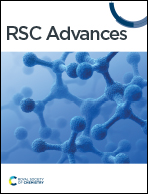Label-free detection of Aβ-42: a liquid crystal droplet approach for Alzheimer's disease diagnosis
Abstract
This study introduces a biosensor based on liquid crystals (LC) designed to detect the Aβ-42 biomarker, commonly associated with Alzheimer's disease. The sensor utilizes LC droplets created using a PEI/Tween-20 surfactant mixture, arranged radially in an aqueous solution. These droplets are coated with the Aβ1–16 antibody, enabling the detection of the Aβ1–42 biomarker. The key advantage of this biosensor lies in its ability to directly translate the antigen–antibody interaction into a change in the molecular orientation of the LC droplets, simplifying the detection process by removing additional procedural steps. Specifically, this immunoassay induces a transformation in the nematic droplets orientation from radial to bipolar upon successful antigen binding. When only the Aβ1–16 antibody coated the LC droplets, no change in orientation was detected, confirming the reaction's specificity. The orientation shift in the LC droplets indicates the formation of an immunocomplex between the Aβ1–16 antibody and the Aβ1–42 antigen. The LC droplet immunoassay effectively detected Aβ1–42 antigen concentrations ranging from 45 to 112.5 μM, with the Aβ1–16 antibody immobilized on the droplets at a concentration of 1 μg mL−1. These findings suggest that the LC microdroplets' orientational behavior can be harnessed to develop a biosensor for the in vivo detection of various proteins or pathogens in a PBS aqueous medium. Owing to its label-free nature and distinct optical signaling, this LC droplet-based immunoassay holds promise for further development into a cost-effective, portable diagnostic tool.

- This article is part of the themed collection: RSC Advances Physical Chemistry year in review 2024


 Please wait while we load your content...
Please wait while we load your content...